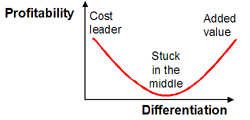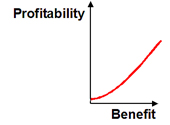|
Porter's Smile
Michael Porter's ideas on strategy are widely accepted. Numerous surveys single him out as the most important business theorist. His theory on attaining a competitive advantage has been the most solid base for developing a strategy in the past 25 years, and is used by almost any firm that is working on a new strategy. In one of the past issues, we described the Value Innovation Strategy - a challenge on Porter's doctrine, but this time we focus on Michael Porter himself, and on one of the major concepts in the heart of his theory.
Porter claims that there are two major and different directions to maintain long-term high profitability rates compared to your competitors in an open competition market:
- The first way is to be a Cost Leader - offering lower prices than your competition. This may be achieved by a tight control over costs, and by leveraging a size advantage through mergers and acquisitions, among other things. Companies such as Cisco, Ikea and GE enjoy a massive purchasing power, enabling them to buy materials, equipment, services and technology for cheaper prices, and then selling for lower prices and high volume (compared to the competition), and still reaching high profitibility.
- The second way is to offer some added value, which is identified with your firm and differentiates it from the competition. An added value is one that the costumers are willing to pay extra for. Such an added value demands an investment in developing original brands with unique features, and another kind of investment - in advertising and PR - in order to communicate the added value (Mercedes = luxury, Volvo = safety, Toshiba = sharpness). Alternatively, an added value may be obtained by focusing on one type of costumers in the market (a market niche), and giving them an improved expert solution. For example - a car manufacturer specializing in taxi-cabs, a travel agency catering for youth travel, or a book shop offering only professional books. Both options - branding or niche - create a useful and clear added value, thus allowing the sales of products and services for a higher price, in turn leading to higher long term profitability.
Porter illustrates this idea with the help of the following diagram:

The graph, shaped like a smile, shows that high profitability (measured on the Y axis) is attained only by firms that are on the tips of the smile - those that lack any differentiation (offering regular products for cheap prices), or those that differentiate themselves (offering a major added value). What about the companies that are located in the middle of the graph? Porter calls those "stuck in the middle", and notes that these companies (making up some 80% or more of the competition in most markets) suffer from low profitability and a lack of competitive advantage. These companies, claims Porter, try to offer "not so high" prices, and "some advantages", and end up losing out both ways. On the left they lose to the large and cheap companies, and on the right they lose to those that offer a significant added value.
Therefore - if your company is "stuck in the middle" it may be time for you to decide: should you compete over price (and thus grow and become more efficient), or should you compete over added value (and thus act towards branding or market niche focus).
Consider it from the costumers' point of view (rather than the economist's - Michael Porter's - point of view), in which both ends of smile are comparable. If we "fold" the smile vertically over the middle, we would get this slope:

Down the slope are companies that do not offer any clear benefit, while up the slope are those that offer a clear benefit to the costumer (low price, unique feature, specialized solution). The companies up the slope are more prifitable, and keep their advantage in the long run. Now then - where are you on this graph?
|


